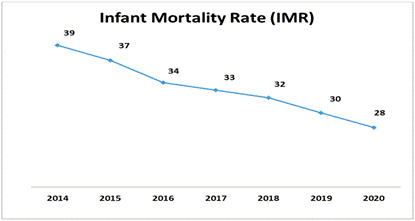New Delhi: India has achieved landmark feat in reducing the infant mortality rates. As per the Sample Registration System (SRS) Statistical Report 2020 released recently by the Registrar General of India (RGI), the country has been witnessing a progressive reduction in infant mortality rate (IMR), under-5 mortality rate (U5MR) and neonatal mortality rate (NMR) since 2014.
The significant achievement will help India achieve the Sustainable Development Goals (SDG) targets by 2030.
IMR has also registered 2-point decline to 28 per 1000 live births in 2020 from 30 per 1000 live births in 2019, which shows an annual decline rate of 6.7%. in 2014, the IMR was assessed to be 39 per thousand births.

NMR too has come down by 2 points to 20 per 1000 lives in 2020 against 22 per 1000 live births in 2019 with an annual decline rate of 9.1%. It was 26 in 2014.
U5MR for the country has shown significant decline of 3 points (annual decline rate: 8.6%) from 2019 (32 per 1000 live births in 2020 against 35 per 1000 live births in 2019). U5MR was found to be 45 in 2014.
 Union health and family welfare minister Mansukh Mandaviya congratulated the nation on this achievement and thanked all health workers, caregivers and community members for relentlessly working towards reducing child mortality.
Union health and family welfare minister Mansukh Mandaviya congratulated the nation on this achievement and thanked all health workers, caregivers and community members for relentlessly working towards reducing child mortality.
“There has been sustained decline since 2014, as revealed by SRS 2020. India is poised to meet 2030 SDG targets of child mortality under leadership of Prime Minister Narendra Modi with focused interventions, strong Centre-state partnership and dedication of all health workers”, he stated.
U5MR for Female is higher (33) than male (31). There has been a decline of 4 points in male U5MR and 3 points in female U5MR during the corresponding period. Highest decline of U5MR is observed in the State of Uttar Pradesh (5 points) and Karnataka (5 points).
Six states/union territories (UTs) have already attained SDG target of NMR (<=12 by 2030): Kerala (4), Delhi (9), Tamil Nadu (9), Maharashtra (11), Jammu & Kashmir (12) and Punjab (12). Likewise, eleven states/UTs have already attained SDGs target of U5MR (<=25 by 2030): Kerala (8), Tamil Nadu (13), Delhi (14), Maharashtra (18), J&K (17), Karnataka (21), Punjab (22), West Bengal (22), Telangana (23), Gujarat (24), and Himachal Pradesh (24).




